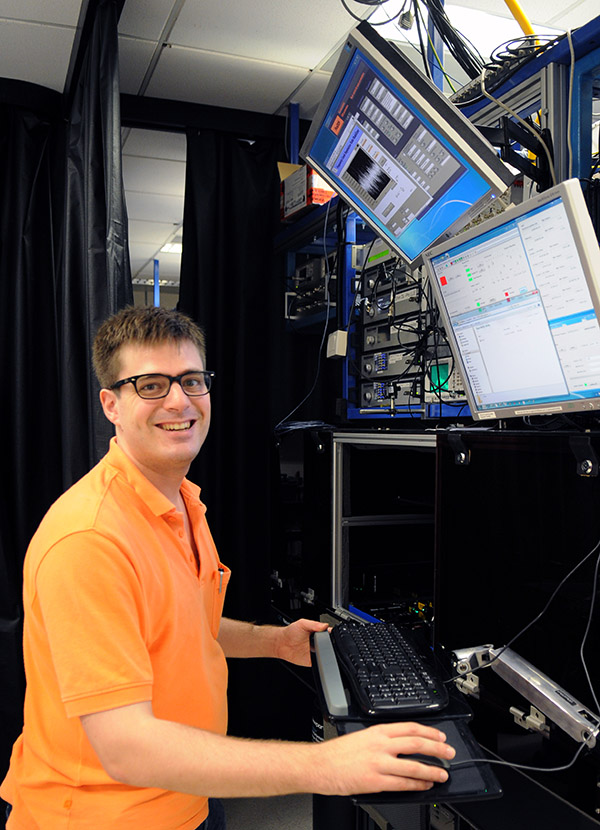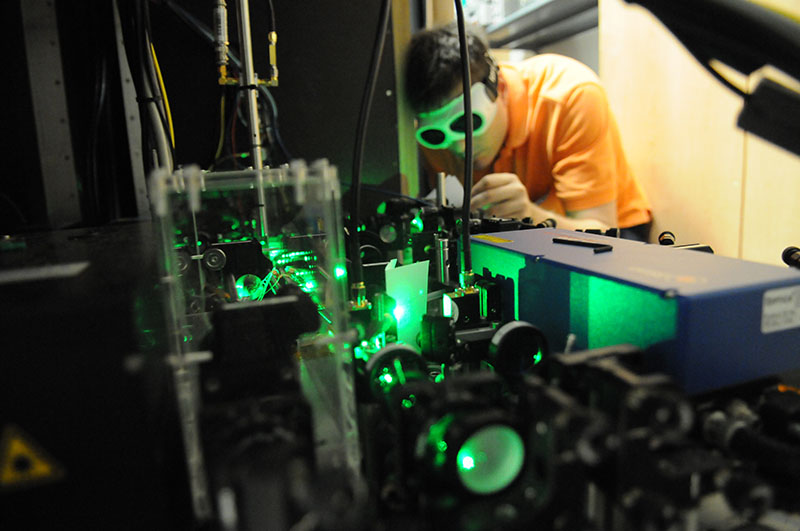Highlights
Meet a CQTian: Johannes Gambari

Johannes manages what is probably the world's only optical frequency comb on Twitter.
Who are you?
I'm Johannes Gambari. I'm a postdoc in Kai Dieckmann's Quantum Matter group and I've been working here at CQT for 2.5 years. I really enjoy the place – there are lots of speakers, a lot of people come to visit the labs, and there's an environment where people can discuss wild ideas, normally physics-related but not always.
What is your research?
I am an experimental scientist – I work with theory and equations, but I mainly use the equations to understand what I can do in the physical world, and how I can use physics to create something. More specifically, I am working with lasers, trying to improve and optimise laser systems to perform laser cooling experiments.
What's the goal of the experiment?
Making polar molecules, which should be very for many things for example making quantum simulators. We can find analogies between complicated physical systems and this quantum system we'll have in the lab, then use the lab system to better understand the physics. On the way there is a lot of technology to develop, and I see the development of technology and skills as being one of the main aims.
Tell us about the laser system you manage
It's an optical frequency comb that produces light at lots of different frequencies – a rainbow light. Most people when they see a rainbow they say, oh look there's a rainbow. I get to see one every day in the lab and I still am not tired of it.
My daily job is often about adjusting knobs and screws to make small optimisations to make the laser run at its best. The question of what is the best, that's physics. That needs analysis and programming, calculations and data analysis.
We want the laser frequency to be as stable as possible. One thing I've done recently is build a system that uses GPS time-signals and a high-finesse cavity to enhance short term stability, so that we can do our experiments without having to buy very fancy equipment. Our solution is an efficient way of making a small improvement using very few optical components. This is technology that I think could find applications elsewhere.
What about the work do you enjoy – or not enjoy?
I enjoy the company – we are quite close as a team. There is a lot of laughter in the lab. We are always making jokes, probably jokes that nobody else can understand. Right now, for example, we are chasing 'Heisenbugs'. There are three things in the experiment that take turns to break. It's a bit like the Heisenberg Uncertainty Principle: when you look for the bug it doesn't exist, but when you're not looking for it, it's there.

Sometimes Johannes' lasers keep him on his feet all day, but he never tires of the rainbow light.
Something I don't like is standing up for more than eight hours a day. Sometimes I have to do this when there is a problem with the laser, which is all on tables, which needs solving right away. I dream of having it fully computer controlled so I can just sit at my desk. Now half the laser is computer controlled. I can also monitor it from Twitter.
From Twitter, you say?
Yes, the laser has a twitter account. It's tweeting the laser frequency every three minutes. Sambit, a PhD student in our group, is the genius who set this up. I would like to think that this is the only tweeting frequency comb in the world!
The tweets show me fluctuations in the frequency to mHz level. The perfect setup would give a frequency that is exactly 250MhZ point zero zero zero, and right now I get a fluctuation of about plus or minus half a mHz on average. Essentially from one number, I can know if I can be somewhere else or I have to run down to the lab.
What about life outside of work?
I love travelling. I am always looking for new places to go and adventures. When I cannot travel, then I enjoy time with family. You could say I'm leaning towards family. I'm getting married this year, so there are lots of arrangements to make. I met my future wife in London but she's Singaporean. She's the reason I first started looking for jobs here.
We always have a lot of errands to run, but it becomes fun because you are doing it with people you are close to. I am half Italian, half Swedish and Singaporean families are more like my Italian side – it's a group of people who help each other out.






